|
Home Page
Glen Echo
The Town
Chautauqua
Amusement Park
• Post Cards
• Souvenirs
• Tickets
• Early Programs
Modern Times
History Book
Cabin John
The Town
The Hotel
Amusement Park
The Bridge
Legends
History Book
Great Falls
Post Cards
Other Stuff
Conduit Road
The Trolleys
Buildings
The Aqueduct
The Road
General
Capital Transit Passes
Historic item Trader
Minnie Brooke Postcards
|
A History of the Glen Echo Chautauqua
© 1997, Richard A. Cook
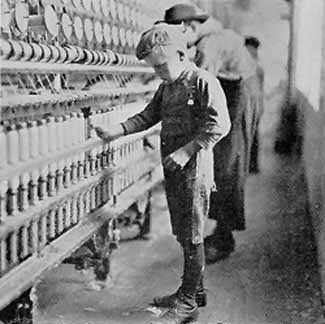
Young child tending the bobbins on an automated loom
A Chautauqua at Glen Echo
Glen Echo Park, located within the town of Glen Echo in Montgomery County Maryland, is an unusual place. Unlike most national parks, Glen Echo has no vast forests or natural marvels, no monuments of national significance, nothing which, on the surface, seems to qualify it as a national park. Glen Echo is a different kind of park, a "People Park."
For the past one hundred years Glen Echo has been about people, about our society and culture. It has been a reflection of life in the neighboring city of Washington D.C. Washington has in turn been a mirror of American society in general. Glen Echo's beginnings are deeply entwined with the cultural environment of America during the last half of the nineteenth century.
The years from the close of the Civil War to the middle 1880's were years of upheaval in almost every area of American life. Every aspect of traditional life and belief was being questioned. Business, politics, religion and the very origins of man were in question.
Industry was changing. Most small business owners found it impossible to compete with the great industrialists. Huge factories were the new way. The work force had grown to include children, often as young as 8 to 10 years old. Many workers, including children, worked 12 to 14 hours a day. By 1870 workers had begun to organize. The National Labor Union fought unsuccessfully for an eight-hour workday and the end of child labor. In 1877 striking eastern railroad workers clashed with Federal Troops, dozens died. In 1886 police shot laborers on strike against McCormick Harvester Company. By the mid 1880's organized labor was going head to head with the industrialists who staunchly defended their right to pursue capitalism to its most profitable ends.
Contemporary political philosophies reflected the labor situation. Karl Marx predicted the collapse of capitalistic society and the formation of worker states when depressions, brought about by poor working conditions and low pay, resulted in violent overthrow of the existing order. Marx brought his political philosophies into organized labor in 1864 with the formation of the International Workingmen's Association. Russian Prince Peter Kropotkin went a step further by advocating a completely government-free society. His belief was that man, free of all governmental systems, is naturally predisposed to live in a cooperative and harmonious manner. These and other new philosophies challenged the minds of Americans and struck at the core of the Democratic-Capitalistic system.
Orthodox religious beliefs were perhaps the most questioned of all. The Unitarian Church found "room for skepticism" about orthodox Christian doctrine. New religious groups formed including Christian Science, which found "new meaning" in the Christian scriptures. Scientists and Archaeologists presented evidence, which seemed to conflict with the Bible. Publication of "The Descent of Man", in 1871, by Charles Darwin increased the uproar. Not so much by questioning man's origin, but that evolution, by contradicting the Bible seemed to undermine the very basis of Christian belief.
One reaction to a questioning society was the formation of Chautauqua. During the 1860's John Heyl Vincent, a Methodist Minister, had developed a growing concern about the poor quality of education in adult Sunday School classrooms, where many Americans received their only education beyond grade school. Vincent recognized the need for continued education to enable the common man to deal with a changing world. Laymen with no previous teaching experience often taught Sunday Schools. Vincent saw that by raising the training level and general educational level of these teachers the overall quality of education within the Sunday School system could be improved. Vincent believed in balance within education, that religious training alone, without historical background, adequate recreation and exposure to the arts, tended not to foster a desire to think but to become dogmatic and sectarian.
During this same time Lewis Miller, a successful inventor and businessman, pursued a similar course. Appointed a Sunday School Superintendent as a young man in his twenties. Miller pioneered the dividing of Sunday Schools into various age groups. In the 1860's he designed a Sunday School building which would become a model for the entire country. In 1868 Vincent and Miller met in Akron, Ohio. Their common dreams for Sunday School improvements were melded into a plan to establish a yearly meeting to uplift the quality of Christian training and general education within Sunday School classrooms. This plan was the foundation of Chautauqua.
In 1874 Chautauqua opened its first season on the shores of Chautauqua Lake in southwestern New York State. Vincent and Miller created in Chautauqua an environment in which education could improve the condition of the average man, a place where science and religion could find balance and compatibility, a place where every political philosophy could find an open platform, not to proselytize but to inform, a place where education could begin to close the gap between laborers and industrialists.
By the late 1880's Chautauqua had grown into a powerful force in American culture. Chautauqua summer camps had sprung up around the country with fifty-two Chautauquas recognized by the parent organization in New York. The Chautauqua Literary and Scientific Circle (C.L.S.C.), a combined correspondence school and local meeting group, had chapters in many cities throughout the country. One chapter opened in Washington D.C.
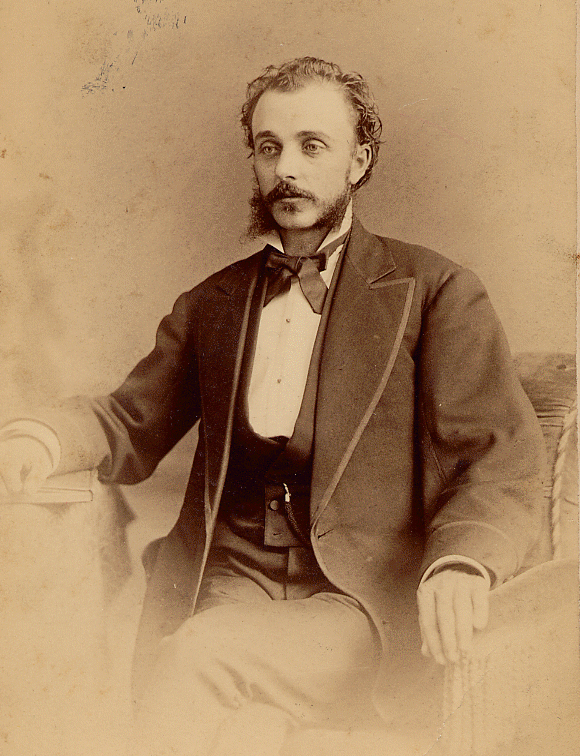
Edwin Baltzley, the founder of the Glen Echo Chautauqua
A Chautauqua at Glen Echo
Into this restless environment grew two young men. Born in 1848, twin brothers, Edwin and Edward Baltzley were the last children of David C. and Susan Howe Baltzley. Their father a prominent industrialist in their home town of New Philadelphia, Ohio, and their mother, who came from a family of famous inventors and authors, raised the brothers in an atmosphere which fostered creativity and stressed education.
Edwin and Edward pursued careers, which took them away from their native Ohio. In 1869 Edwin, then in the employ of the Citizens National Bank of New Philadelphia, left his position to become personal secretary to Ohio Senator John A. Sherman. Edwin relocated to Washington D.C. and quickly became established in Washington society. Two years later Edward also moved to Washington to work as a clerk in the office of the First Auditor of the Treasury. Edwin continued in the employ of Sherman when the Senator was appointed Secretary of the Treasury in the Cabinet of President Hayes, and terminated his service at the end of Sherman's term in March 1881.
Edwin had acquired a new direction for his future while at a Washington social function. He was advised by William W. Corcoran (the Washington financier) that with recent improvements in transportation, more and more people would leave the city's "bad airs" to establish homes in the purer, more idyllic surrounding areas and that these sub-urban properties were a potential gold mine.
Edwin secured a position as a government clerk while applying his spare time to the field of inventing. In March of 1885 Edwin applied for a patent on "certain new and useful improvements in culinary beaters". Edwin's new eggbeater led the brothers to Philadelphia Pennsylvania where they founded the Keystone Manufacturing Company to produce and distribute their product. Soon Edwin amassed a personal fortune in excess of $250,000-equivalent to roughly $12,000,000 in today's currency.
By 1888 Edward had returned to Washington and in July of that year purchased 516 acres on the heights overlooking the Potomac River just outside of Washington in Montgomery County Maryland. The land was bought for $20,000 with $2,000 down and a mortgage for the balance. The fate of the Keystone Manufacturing Company is unknown but the following year Edwin relocated to Washington and the brothers formed the E. & E. Baltzley Company, dealers in real estate.
A portion of the 516 acres was surveyed during the following months but a name for their new development had not been found. The brothers considered many possibilities but were dissatisfied with them all. Baltzley family tradition says that the area was named by their blind housekeeper Guadeloupe, who when overhearing Edwin describing the land as "there is a beautiful glen with the most wonderful echo" remarked "why not just call it Glen Echo." Whether true or not the entire property was named Glen Echo on the Potomac.
The first section of residential lots, opened in 1889, was called Glen Echo Heights. Land sales were brisk with many of Washington's prominent citizens purchasing lots including former president Grover Cleveland, and a former Secretary of the Navy.

Glen Echo trolley in front of Edward Baltzley's house
A Chautauqua at Glen Echo
Transportation to Glen Echo was next on the Baltzley's agenda. The long carriage ride from the city discouraged many potential buyers. In December of 1889 the Glen Echo Railroad Company was chartered to build a trolley line to Glen Echo from Tennallytown (at the present location of Tenley Circle on Wisconsin Avenue near the Maryland/D.C. line).
The brothers' longer-term plans were to develop Glen Echo as an independent community with a restaurant, post office and shops. The restaurant took precedence as the Baltzleys saw its potential to assist in the sale of lots. The Glen Echo Cafe, named PA-TOW-O-MECK, was built between February and July of 1890 and opened on July 25th. The opening ceremonies were a grand affair attended by Washington's social set including a number of Senators. The Cafe had a rustic appearance being built almost entirely of rough-hewn cedar logs. However the interior was decorated with the most luxurious furnishings available. The Cafe was an immediate success and the Baltzleys' assumption proved correct. Land sales boomed.
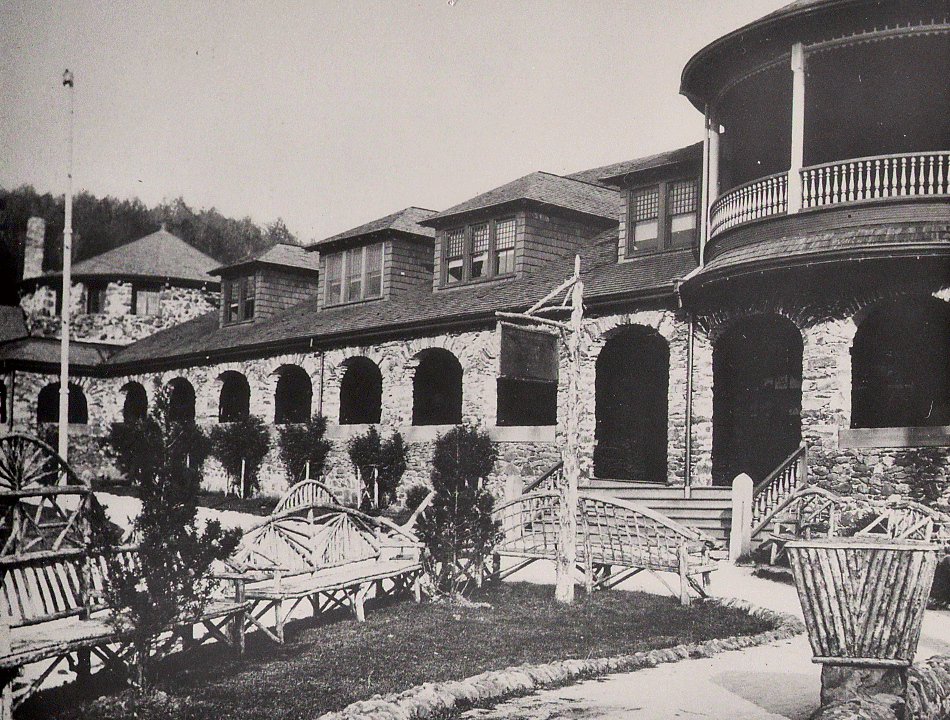
The main office building and restaruant at the chautauqua
A Chautauqua at Glen Echo
During the summer construction began on a post office and a series of small shops, but the brothers, plans were not finished. Edwin's wife Edith had become involved with the Washington chapter of the C.L.S.C. and Edwin quickly saw the potential of Chautauqua as a means to further land sales at Glen Echo. On November 22nd an 80-acre section of Glen Echo on the Potomac was surveyed for the development of a Chautauqua Assembly. Exactly one-week later disaster struck. The Cafe caught fire in the night and in less than two hours was completely destroyed.
The Baltzleys, being creative businessmen made the best of the situation. Edwin had written a promotional brochure about the Cafe and the proposed Chautauqua, which was being printed at the time of the fire. Even though over eighty percent of the brochure was written about the now defunct Cafe, Edwin added but a single paragraph to the text telling of the Cafe's destruction. The final sentences reveal his feeling. "It was an air-castle, a dream with a rude awakening. It will be rebuilt in stone."
Though the loss of the Cafe was a setback (insurance covered less than one third of the $75,000 costs) the brothers were undaunted. Edwin quickly found a new residence for his family, they had been living in a small cottage atop the Cafe, and within four days business returned to its normal pace. Without the responsibilities of managing the Cafe more time was available for the Chautauqua project. By December 20th the organization of the Chautauqua was complete.
Construction of the Chautauqua buildings began on February 1st 1891. George Freeman Pollock, who was later instrumental in the formation of the Shenandoah National Park, was the timekeeper. Pollock recalled the construction activity years later in his memoirs.
"In six months the number of employees jumped from 50 to 300 and as cottages and homes began to go up like magic all through the Chautauqua grounds, an additional 300 masons were brought from New York. Soon there were 900 men on the payroll."

The Glen Echo Chautauqua ampitheatre
A Chautauqua at Glen Echo
Included in the construction plans for the first year were an 8000-seat amphitheater, a hall of philosophy, a restaurant/hotel and the completion of the post office and store buildings. The post office and stores constituted the entrance complex to the Chautauqua grounds. The endeavor progressed quickly and on February 24th the National Chautauqua of Glen Echo was incorporated in West Virginia. In April 80 acres of land were formally deeded from the Baltzleys to the new Chautauqua Association. By May the amphitheater walls were up and on the 20th a cornerstone laying ceremony was held. The Glen Echo Railroad powerhouse was under way and grading for the tracks had begun. In spite of an unusually rainy spring, 78 days of rain between February 1st and June 16th, all of the buildings were substantially complete by the start of the first Chautauqua season on June 16th.
The Baltzley's planned that the Glen Echo Chautauqua would outshine even the original Chautauqua Institute. All of the buildings were to be granite. Nine quarries were opened on the property to provide material for the Chautauqua buildings as well as for homes and summer cottages. Plans for the second year called for the building of a school of fine arts, a Women's temple and an ornate five story hotel.
Early in the year the brothers convinced Miss Clara Barton founder of the American Red Cross to locate her headquarters at Glen Echo. As an enticement they gave her land and offered her free labor to construct a building. Miss Barton had lumber from the Johnstown, Pennsylvania, Red Cross Hotel (Hospital) with which she wished to build the structure. The lumber was "rough and full of nails" according to Edwin Baltzley but in order to comply with Miss Barton's wishes a portion were "woven into the structure." To match the other Chautauqua buildings the Red Cross Building was given a massive granite facade with a large red brick cross above the second story windows.
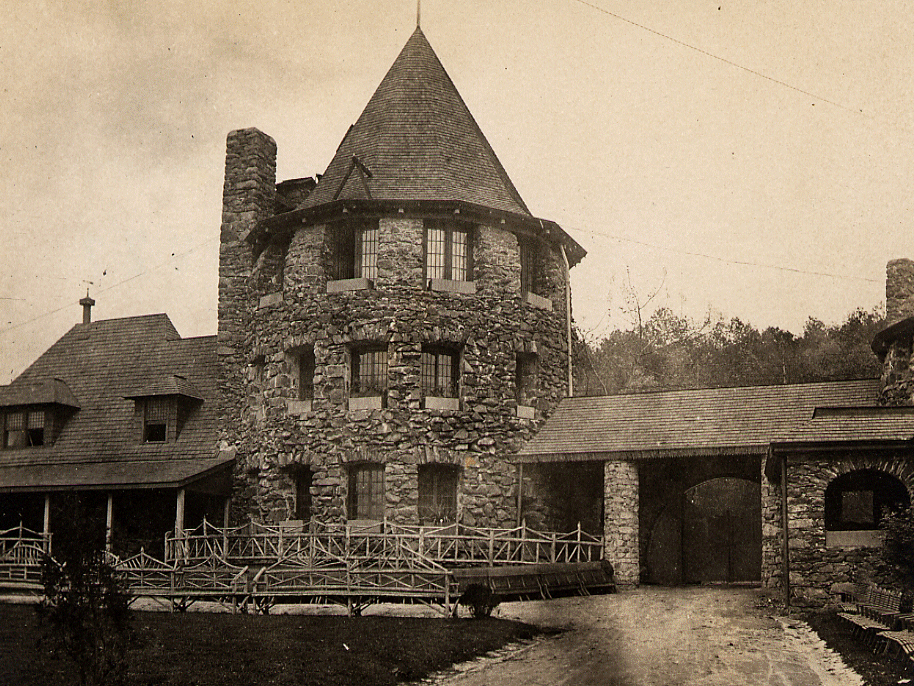
The chautauqua bell tower (still standing)
A Chautauqua at Glen Echo
To assure high attendance the Baltzleys recruited an impressive and diversified staff. Several of the staff had long histories of experience with Chautauqua including the Chancellor Dr. A. H. Gillet, and the Women's Department Secretary, Mrs. Susie Birch Jennings. Mrs. Jennings' experience extended back to the beginnings of the New York Chautauqua. Clara Barton headed the Women's Executive Committee. On the committee were prominent women from throughout the United States, including Mrs. John A. Logan, Mrs. Major John Wesley Powell and Mrs. Leland Stanford. Dr. Henry Spencer founder of the Spencerian Business College headed the Business School. The Board of Trustees included William T. Harris, the U.S. Commissioner of Education.
Classes and lectures were available in all areas of the liberal and practical arts. Many of the classes were specifically oriented towards the causes which brought about Chautauqua including Bible School, New Testament Greek, Bible for Sunday School teachers, Christian labor reform and method training for Sunday School teachers. Other classes covered more traditional subjects such as archaeology, art, astronomy, English literature, music, music history, and physical training. In addition to traditional courses for women the Women's department offered a progressive course in home maintenance and repair.
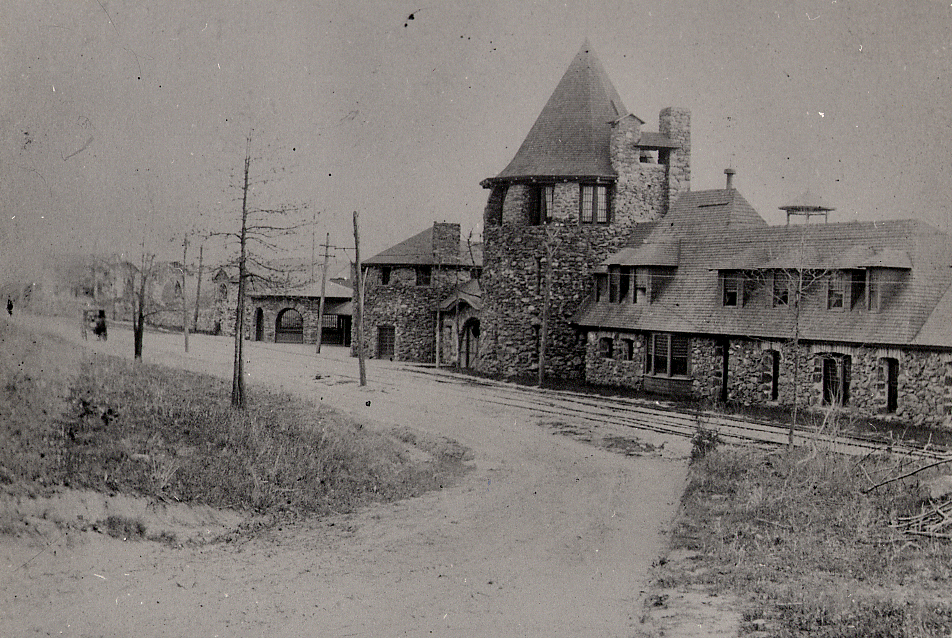
The Glen Echo Chautauqua entrance complex
A Chautauqua at Glen Echo
Activities were varied. Like a university, each course had a separate tuition fee. In addition an admission ticket was required to enter the Chautauqua grounds. However this general admission included access to various activities in the amphitheater, outdoor sports activities (including baseball and lawn tennis), Vesper Services, prayer vigils and of course the enormous camp fire each evening. The campfire was the scene of much singing and story telling as well as quite a few unapproved romances. Sunday was reserved for religious observances and as such no campfire was held.
In spite of the failure of the trolley line to be operational for the opening day, one thousand people attended the ceremonies. By the end of the first week nearly 500 people had settled in for the two week season. The majority of these residents lived in a "tent village." In typical Victorian style this was a far cry from roughing it. The tents had wooden floors and electric lights. Chairs, tables, rugs and cots could be rented on the grounds and meals were available at the "tent hotel."
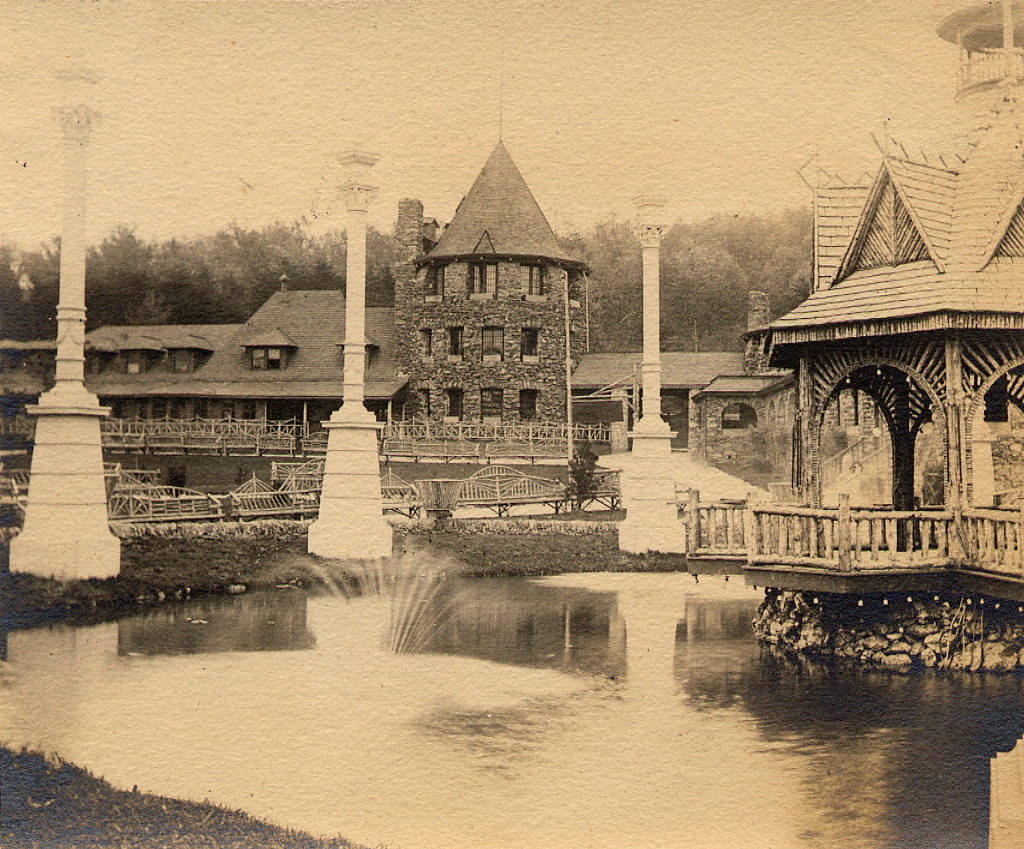
The band stand and fountain
A Chautauqua at Glen Echo
The huge success of the first week prompted the Chautauqua Association to extend the season to August 1st. Some activities were less than academic. Chautauqua goers wandered about the grounds, which were filled with twisting paths. The paths were self-guiding, lined with carved cedar signs expounding the obvious beauty of the surroundings. At night, paths dimly lit with small colored electric lights provided an atmosphere conducive to romance. To limit these trysts Dr. Gillet imposed a 10:00 p.m. curfew. Dr. Gillet's own daughter was reported to have violated the curfew on several occasions.
To balance the academics humor was not forgotten. Regular humorous performances were given. One speaker, Mr. Jahu De Witt Miller, expounded on "Love, Courtship and Marriage." Mr. Miller felt well qualified to address these matters since he had no personal experience with any of the three subjects. The Chautauqua Band interspersed classical performances with current popular and comedic works. In all a light vacation atmosphere was maintained.
The first season ended on August 1st with long farewells and the slow process of breaking camp. The season was a financial success. Total expenses of nearly $500,000 had been offset until the indebtedness of the Chautauqua Association was less than $40,000. Everything looked encouraging until disaster struck again. Dr. Henry Spencer, Director of the Chautauqua's Business School, became ill suddenly and died of pneumonia before the end of August. Rumors were spread that Spencer had died of malaria contracted at Glen Echo.
Glen Echo became a byword for disease. Land sales practically ceased. In spite of a strong advertising campaign Glen Echo acquired an undeserved reputation as an unhealthy place. Except for a Fourth of July celebration efforts for an 1892 season were canceled when it became apparent that the public was convinced that Glen Echo was rampant with malaria. Years later Clara Barton, a woman familiar with sickness was to discount rumors that Glen Echo was a nest of disease.
Again in 1893, the Baltzleys scheduled a Chautauqua season to begin, but this season was also canceled. The depression of 1893 was to seal the fate of the Chautauqua, but the Baltzleys, determined to recover their losses, decided to stick with their efforts. Financial conditions continued to deteriorate. By 1894 a mortgage on the land was in default. In 1985 due to the failure of the Chautauqua to provide adequate ridership, the Trolley Company was sold at public auction. Terms were renegotiated to hold off foreclosure for a few years, and the brothers were able to keep the Chautauqua Association alive until late in 1896, although the Baltzley's assets were gradually slipping out of their control.

The Glen Echo Chautauqua during the vaudeville era
A Chautauqua at Glen Echo
Edward Baltzley gave up the endeavor in 1897 and moved to Colorado. Edwin remained behind to manage the property. Entertainment replaced education and in July of 1897 vaudeville came to Glen Echo. The classical music presentations of previous years gave way to jugglers, acrobats and "fancy dancers". From 1897 to 1899 the old Chautauqua grounds were used for everything from prize fights to light opera.
Culture returned in 1899, when the United Daughters of the Confederacy of Maryland and Virginia held their annual encampment at Glen Echo. President William McKinley gave a keynote speech. Other speakers included Senators, Governors and religious leaders from Maryland, Virginia and Washington D.C. Luncheon in the amphitheater consisted of beef, bacon, hardtack and coffee.
Under the conditions of incorporation the Baltzley brothers were not financially liable for the debts of the Chautauqua Association. Edwin, however, had sunk his entire personal fortune into the developing Glen Echo. For years Clara Barton tried to help the Baltzleys by periodically purchasing land from the brothers to enable them to retain title to the property. Edwin managed to hold on until 1903, when declining income from the properties made it impossible to make adequate payments on two liens against the Chautauqua grounds. After considerable effort to retain control in the Maryland Circuit Courts, foreclosure proceedings turned over title to the receivers of the Baltimore Building and Loan Association. The Chautauqua grounds and buildings, which had cost nearly one million dollars, were disposed of for $15,000.
The Baltzley Brothers fared poorly after Edward, as noted, had moved to Colorado in 1897 to prospect for gold with his son Clarence. His eager pursuit of gold was ultimately his downfall. Around 1904 Edward became extremely ill and was confined to a hospital in Hot Springs Arkansas where he died in 1907. The cause of death was mercury poisoning brought about by trying to amalgamate gold from ore using mercury in his bare hands. Edwin lived out his remaining years in the home of his son, Louis, in Glen Ridge, New Jersey, never losing his love for Glen Echo, and spending much of his time wrapped in memories of better times. At his death of cancer in 1919, he was penniless.
Note
Now in its second printing, Glen Echo Park: a story of survival presents a more comprehensive history of Glen Echo, including nearly 100 high quality photographs of the Chautauqua and Amusement Park through the years.
The book is available HERE
|
|




